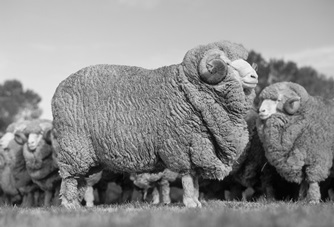Material Types and Sources
We have set out some information and backgound to certain of our base materials.
We go to great lengths to ensure that we obtain the best fibres of their kind from the most suitable and sustainable sources.
All of our wool types are museling free and we do our utmost to ensure that the supply is ecologically sound and from sources where there are no oppresive labour issues.
However, key is the selection and grading of the fibre and we hope that this care is reflected in thequality of yarns we sell.
Please find more information below
| ![Material Types and Sources Material Types and Sources]() |
|
 | Merino Background
The Merino sheep owes its origin to the Spanish breed that found its way to such colonies as Australia and New Zealand in the days of the British Empire. The production of Merino wool in Australia is now the largest in the world, the micron ranges from 24 to 17.5/18 in commercial quantities. The wool has superb whiteness and softness and is widely recognised in the consumer markets as the premier quality of wool. |
|
 | Alpaca Background
The alpaca is a species indigenous to the Andes. Members of the South American camel family, alpacas, along with the vicuña, guanaco and llama, live at altitudes ranging from 2,500 to 4,500 meters above sea level. Here these animals tolerate temperature variations of more than 40°C.
Due to harsh weather conditions prevailing in the Andes and a unique protein-free diet, alpacas grow a fine hair with remarkable softness, fineness, length and strength.
The unique fibre offers a wide range of natural colours up to 30 standard shades.
Types
There are approximately 4 million alpacas in South America; Eighty percent of them are in Peru, which are mostly found in the southern region called Puno. The trade of alpaca has always been in Arequipa, a city strategically located in the gateway to the main alpaca production regions. A predominant alpaca type characterised by its fine fleece, spongy, fluffy look and wide range of natural colours. About 95 percent of the fibre processed is Huacaya. The least common alpaca type, it has a lustrous and silky fibre. This animal has an eye-catching appearance, and produces the highest quality alpaca fibre. Most of the Suris are white and in colour. About 3 to 5 percent of the fibre processed is Suri. Of the main production, this can be sub-divided into the following main fineness grades: -Baby Alpaca "Premium Alpaca" This is selected and graded into the most fine commercial grade if Alpaca being 21.5 to 23.5 microns in fibre diameter, knitglobal's Alpaca types are made exclusively from this type of Baby Alpaca that has is supersoft and has a fabulous handle
|
|
Mohair Background
Angora goats evolved on the Anatalian Plains of Turkey near the city we now know as Ankara and from which the name "Angora" derives. The term "mohair" apparently derives from Arabic (mukhayyar).
Angora goats were highly regarded and jealously protected from exportation until the sixteenth century when the Angora goat was introduced into Spain and France. The two principle areas of today's supply are South Africa and America.
Our Superkid Mohair yarn is produced from the finest fleece from the largest producing area of West Texas in the United States, Texas Angora goats have lived on the ranches there for many generations and the Mohair produced the softest found.
|  |
|
Yarnundyed Euro order site

